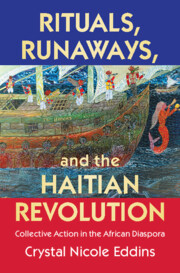Book contents
- Rituals, Runaways, and the Haitian Revolution
- Cambridge Studies on the African Diaspora
- Rituals, Runaways, and the Haitian Revolution
- Copyright page
- Dedication
- Contents
- Figures
- Tables
- Acknowledgements
- Introduction
- I Homelands, Diaspora, and Slave Society
- II Consciousness and Interaction: Cultural Expressions, Networks and Ties, Geographies and Space
- 3 “God knows what I do”: Ritual Free Spaces
- 4 Mobilizing Marronnage: Race, Collective Identity, and Solidarity
- 5 Marronnage as Reclamation
- 6 Geographies of Subversion: Maroons, Borders, and Empire
- III Collective Action and Revolution
- Conclusion
- Notes
- References
- Index
3 - “God knows what I do”: Ritual Free Spaces
from II - Consciousness and Interaction: Cultural Expressions, Networks and Ties, Geographies and Space
- Rituals, Runaways, and the Haitian Revolution
- Cambridge Studies on the African Diaspora
- Rituals, Runaways, and the Haitian Revolution
- Copyright page
- Dedication
- Contents
- Figures
- Tables
- Acknowledgements
- Introduction
- I Homelands, Diaspora, and Slave Society
- II Consciousness and Interaction: Cultural Expressions, Networks and Ties, Geographies and Space
- 3 “God knows what I do”: Ritual Free Spaces
- 4 Mobilizing Marronnage: Race, Collective Identity, and Solidarity
- 5 Marronnage as Reclamation
- 6 Geographies of Subversion: Maroons, Borders, and Empire
- III Collective Action and Revolution
- Conclusion
- Notes
- References
- Index
Summary
This chapter focuses on the spiritual world of enslaved people and the ways in which politicized consciousness and resistance were infused in ritual practices. This chapter is theoretically grounded by insights from the social movements field related to the politicization of social spaces and the role of cultural artifacts in social movements. I frame spiritual and ritual gatherings as free spaces where participants’ oppositional consciousness and sense of racial solidarity was enhanced through holding audience to anti-slavery and racial consciousness rhetoric; employing spiritual technologies to protect oneself and attract good fortune, usurping ultimate power from white plantation owners and asserting personal agency; and using marronnage to organize and recruit new ritual participants.
- Type
- Chapter
- Information
- Rituals, Runaways, and the Haitian RevolutionCollective Action in the African Diaspora, pp. 111 - 146Publisher: Cambridge University PressPrint publication year: 2021

